I have a question regarding how DC connections are established on the new Tesla branded inverter.
I have a 21KWhr solar roof with several powerwalls and three 7.6Kw inverters.
Shortly after installation I noticed that one of the three Tesla inverters seemed to take a very long time (hours) to come online. Often it would not come online at all and would continuously cycle through self test. Tesla dispatched a couple of guys and they doubled up the wiring connections on the inverter. Or to put it another way DC comes into the lower terminals and they installed jumpers connecting terminals one and three, and two and four so DC power enters the inverter on four inputs. Yes if I look at the inverter through the web browser it shows power on all four inputs even though there are only two strings coming in.
My question is does this scheme lower the amount of power that is converted to AC or does it not make a difference? The reason I am asking is that I used to get 17.5 to 18.00 kW on the entire system mid day and now I am only getting 15kW, Nothing has changed except this wiring modification.
Any electrical engineers out there that can explain this? Also why changing to this wiring method did the original problem go away? Now it comes online in a few minutes after completing self test.
Thank you

I have a 21KWhr solar roof with several powerwalls and three 7.6Kw inverters.
Shortly after installation I noticed that one of the three Tesla inverters seemed to take a very long time (hours) to come online. Often it would not come online at all and would continuously cycle through self test. Tesla dispatched a couple of guys and they doubled up the wiring connections on the inverter. Or to put it another way DC comes into the lower terminals and they installed jumpers connecting terminals one and three, and two and four so DC power enters the inverter on four inputs. Yes if I look at the inverter through the web browser it shows power on all four inputs even though there are only two strings coming in.
My question is does this scheme lower the amount of power that is converted to AC or does it not make a difference? The reason I am asking is that I used to get 17.5 to 18.00 kW on the entire system mid day and now I am only getting 15kW, Nothing has changed except this wiring modification.
Any electrical engineers out there that can explain this? Also why changing to this wiring method did the original problem go away? Now it comes online in a few minutes after completing self test.
Thank you



